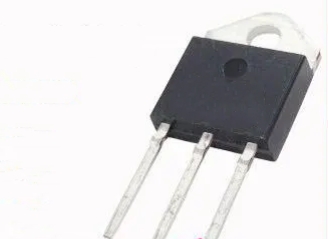- Home
- Products
- Elementary
- Boride Powder
- 3D Printing Powder
- Sulfide Powder
- Oxide Powder
- Carbide powder
- Nitride Powder
- Silicide Powder
- Hydride Powder
- Telluride Powder
- Selenide Powder
- Stearic Acid Series
- Phosphide Powder
- Nanoparticles
- Metal Alloy
- MAX Phase
- Lithium Battery Anode
- Surfactant
- Molecular sieves
- Concrete Admixtures
- News
- Answers
- Contact
- About
Elementary
- 1
- 1
SCR Thyristor: Principles, Characteristics and Maintenance of Semiconductor Switches
If you are looking for high-quality products, please feel free to contact us and send an inquiry, email: brad@ihpa.net
A brief introduction to thyristors
A thyristor is a powerful electronic device. It is a three-terminal component composed of four layers of PNPN semiconductor materials. Its forward working voltage is equal to the reverse breakdown voltage. This is represented by the letter "K" in the circuit, which means "control." Its primary function is to convert alternating current into direct current. A controlled rectifier (SCR) is a semiconductor device with unique functions.
Thyristor mainly consists of three parts:
Substrate, gate, and emitter. The function of the substrate is to convert the input DC current into the corresponding pulsating DC, and the entrance is a multi-sub diffusion transistor (MOSFET), which forms a barrier capacitance internally by adding an electric field between the two electrodes of a PN junction. A conductive channel that generates carriers, and finally, a field-effect transistor (FET) with a metal oxide as the gate electrode. In use, the above three types of semiconductor diodes or transistors with different functions are usually combined and used as an integrated integrated circuit (IC). The first part is called the main chip or single-chip integrated circuit; the remaining two parts are called auxiliary parts or Discrete components.
Characteristics of silicon-controlled thyristor
(1) Voltage-ampere characteristics: Since the equivalent resistance between the drain and the source of the thyristor is minimal when it is turned on when the applied reverse voltage exceeds a specific value, the entire tube can be turned on quickly, and a large forward current IDI can be obtained. Therefore, It's called a fast recovery diode.
(2) Temperature characteristics: Due to thermal balance conditions, ordinary thyristors can only work within a specific temperature range. For commonly used bidirectional thyristors, the maximum allowable junction temperature is 85° when operating at the rated reverse peak current. C; for high-power bidirectional thyristors, the temperature should be limited to between 150 and 200°C.
(3) Frequency characteristics: The frequency characteristics of ordinary unidirectional thyristors, like standard bipolar transistors, also change with the change in power supply frequency. However, it should be noted that due to switching losses, some compensation measures must be taken when working at high frequencies. In addition, there are a few reverse-conducting, low-frequency, low-power swapping tubes (such as Shorell diodes, etc.) manufactured using unique processes.
Things to note when using silicon-controlled thyristors include:
1. Environmental requirements: The use environment should be free of severe vibration and impact, and the environmental medium should be free of impurities and atmosphere that corrode metal and damage insulation. At the same time, the module die operating junction temperature must be -40℃∽125℃, the ambient temperature must not be higher than 40℃, and the ambient humidity must be less than 86%.
2. Heat dissipation requirements: The module must be equipped with a radiator before use, and the selection of the radiator should comply with relevant regulations. Heat dissipation can use natural cooling, forced air cooling, or water cooling. When forced air cooling, the wind speed should be greater than six m⁄s.
3. Correct selection: For high-power thyristors, heat dissipation devices, and cooling conditions must be installed according to the manual requirements to ensure the tube temperature during operation does not exceed the junction temperature.
4. Prevent overvoltage and overheating: SCRs with a core current of more than 5A must be installed with a radiator and ensure the specified cooling conditions. To ensure good contact between the radiator and the thyristor tube, a layer of silicone oil or grease should be applied to help with good heat dissipation.
5. Current control: When selecting the rated current of the thyristor, in addition to considering the average current passing through the component, you should also pay attention to factors such as the size of the conduction angle during regular operation, heat dissipation, and ventilation conditions. At the same time, it is necessary to prevent forward overload and reverse breakdown of the thyristor control electrode.
6. Overcurrent protection: Generally, a fast fuse can be installed in the AC power supply for protection. The melting time of the fast fuse is extremely short. Generally, the rated current of the fuse is selected with 1.5 times the rated average current of the thyristor.

As an essential semiconductor device, thyristor is vital in power electronics, motor control, power supply, and other fields. However, some things need to be paid attention to when using thyristors, such as voltage and current control, heat dissipation, over-current protection, and prevention of voltage shocks. Proper use and maintenance of thyristors can ensure the regular operation of the equipment and extend its service life.
Supplier
PDDN Photoelectron Technology Co., Ltd. is a high-tech enterprise focusing on the manufacturing, R&D and sales of power semiconductor devices. Since its establishment, the company has been committed to providing high-quality, high-performance semiconductor products to customers worldwide to meet the needs of the evolving power electronics industry.
It accepts payment via Credit Card, T/T, West Union, and Paypal. PDDN will ship the goods to customers overseas through FedEx, DHL, by sea, or by air. If you are looking for high-quality scr thyristor, please feel free to send us inquiries and we will be here to help you.
Inquiry us
PREVIOUS NEWS
High Purity Nano Hafnium Hf powder CAS 7440-58-6, 99%
NEXT NEWS
